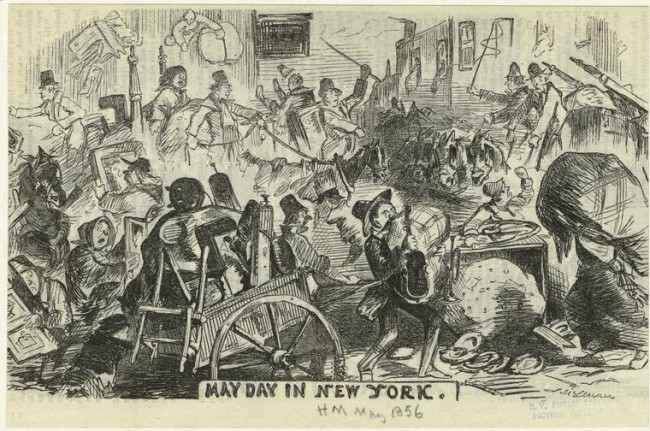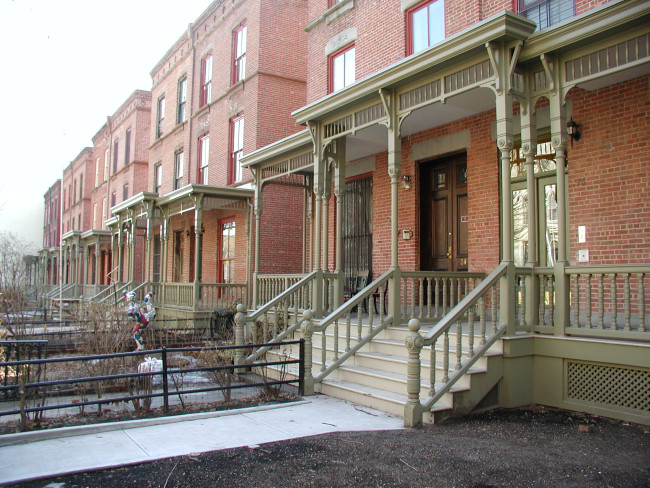Jumel Terrace: A neighborhood with a connection to Hamilton—the man and the musical
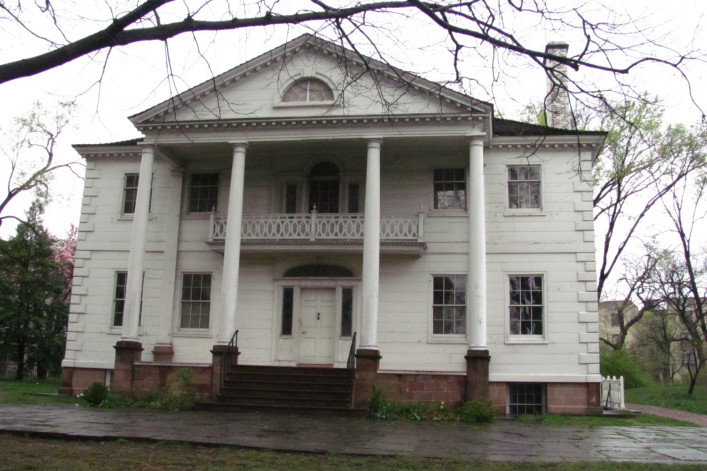
Morris-Jumel Mansion photos: rufus/Flickr
The Jumel Terrace Historic District is one the most interesting neighborhoods in upper Manhattan, and it happens to be full of history. That's probably why Lin-Manuel Miranda chose the Morris-Jumel Mansion (for which the area is named) as a setting in which to write parts of his hit musical. That's right, Tony-darling Miranda wrote two of his blockbusters songs —"Wait For it" and "The Room Where It Happens"— in Aaron Burr's bedroom at the former-home-now-museum, according to the museum itself.
But the mansion and the area that surrounds it predates Miranda by 250 years—with a history interesting enough to (possibly?) eclipse this 21st century footnote.
The Jumel Terrace Historic District, designated by the Landmarks Preservation Commission in 1970, stretches from St. Nicholas Avenue to Edgecombe Avenue, from the south side of West 160th Street to the north side of West 162nd Street. It includes the Morris-Jumel Mansion (once the headquarters of George Washington) and Roger Morris Park within its borders. Its significance is enhanced by the fact that the homes there today are the “original and only construction that has taken place on these sites since they were part of a large country estate and the entire development of the district (with the exception of the mansion) took place in a period of just 30 years," according to the Landmarks report.
Kurt Thometz has lived in the district for 12 years where, until recently, he operated the Jumel Terrace Bookstore from his brownstone. Thometz thinks his neighborhood is “just terrific. It’s where the founding fathers met the founding brothers." Here, five facts you need to know about the area:
1. George Washington really did sleep here, and apparently the political arguments raged on.
The Jumel mansion was built as a country house by Colonel Roger Morris, a loyalist sympathizer, in 1765. According to Landmarks, it is the oldest house in Manhattan, a handsome building, two-and-a-half stories high, typically Georgian in style with an unusual octagonal drawing room on the first floor. Morris and his family—he married Mary Philipse, who some believe spurned a marriage proposal from Washington—lived in the house they called Mount Morris until 1775 when the colonel fled to England.
After the Battle of Long Island, so disastrous for the Colonial Army, Washington retreated from Brooklyn up to what was then known as Harlem Heights and claimed Mount Morris as his home headquarters. That lasted just over a month, until the British captured New York city. During the seven years that the British occupied the city, the mansion was home to General Sir Henry Clinton and his officers and, at the end of the war, was reclaimed by the new government and sold by the Commissioners of Forfeitures, which sold lands that had been confiscated from loyalists after the American Revolution.
In 1790, Washington held a cabinet meeting at the mansion with John and Abigail Adams, Thomas Jefferson, Alexander Hamilton, James Madison, and other luminaries. An elaborate dinner was served before the meeting; the founding mothers and fathers ate outdoors because there wasn’t enough room for a sit-down dinner inside.
According to a recent book entitled Morris-Jumel Mansion, written by the house's director, Carol S. Ward, these dinners were “anything but peaceful — as the raging political ideas of the Founding Fathers were discussed.”
Now a museum, the mansion displays some of the personal belongings of Morris, Washington, and two of its other illustrious occupants, Aaron Burr and Eliza Jumel.
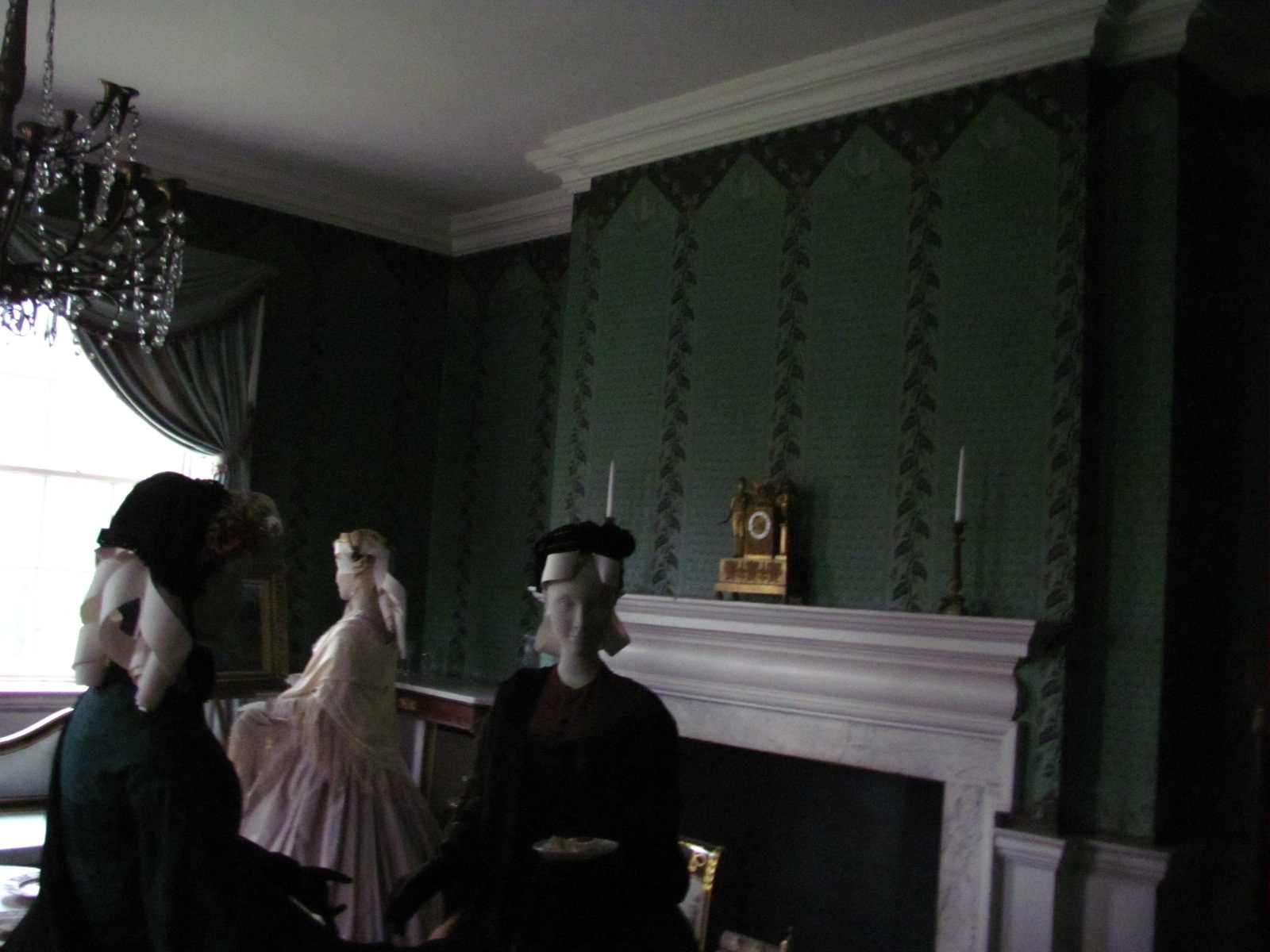
2. Eliza Jumel, daughter of a prostitute and one-time indentured servant, became one of the wealthiest women in 19th-century America.
In The Remarkable Rise of Eliza Jumel, the life story of the woman who, with her husband, bought the mansion in 1810, art historian Margaret Oppenheimer sorts fiction from fact—not an easy task when it comes to Jumel. A whirlwind of rumors surrounded her in life and continued long after her death. Some she encouraged in order to enhance her standing in society, others were the creation of the dozens of relatives and would-be relatives who spent 18 years arguing over her estate.
Jumel’s obituary in the New York Times had some pretty outrageous claims, including the fact that she was present at the first session of the Continental Congress in 1774—quite remarkable for a one-year old. And this phrase, straight from the obituary, which refers to some of her more famous (alleged) suitors and “the scores who bent willingly before her shrine” is positively steamy.
Thometz has called Jumel “one of the grand horizontals” of American history. But, Oppenheimer has a very different story to tell—one of a woman who rose above the abject circumstances of her birth, educated herself, was fluent in French, became a collector of fine art, and one of the very few female real estate moguls of the era. As Oppenheimer says, “Eliza's story is a fabulous one: raised in a brothel, indentured as a servant, and confined to a workhouse when her mother was in jail, she fought her way upwards through sheer grit and guile to become one of the richest women in New York.” Liz Smith, when reviewing Oppenheimers’ book, called Jumel “Scarlett O'Hara’s northern sister—a sister doing it for herself way back in the day.”
Jumel even managed to earn herself the august title of “widow of the former Vice President of the United States” which won her lots of points with European society toward the end of her life. She married Aaron Burr in 1833. It was pretty apparent that Burr had married her for her money and, although the marriage lasted three years officially, the couple spent only a few months actually living together in the mansion. In the end, Jumel outsmarted the wily Burr with the help of her divorce lawyer who happened to be the son of Hamilton.
When asked why Jumel, and her husband Stephen, a wealthy merchant of French origin, bought this particular house and the 140 acres of land that surrounded it, Oppenheimer explains: “The house is located on the second highest point on Manhattan Island and in 1810 the view south down the Harlem River was nothing short of spectacular, and looking East you could see as far as the Long Island Sound. Plus, the property included orchards, meadows and fertile agricultural land, everything needed to ensure that this country estate could also be a profitable working farm.”
For an idea of the vastness of the property, Oppenheimer explains that their purchase “included almost all of the land stretching between 159th and 174th Street between the Harlem River and the Kingsbridge Road (now St. Nicholas Avenue and Broadway) plus a 40-acre lot between the Kingsbridge Road and the Hudson River in the West 170s.”
In 1882, after the brutal battle over her estate came to an end, the mansion and what would eventually be the historic district was auctioned off. The first bid was $25,000 and when it was all over, Nelson Chase, who had married Jumel's adopted daughter, had bought it all for $45,000.
3. The founding fathers weren’t the only famous folks who spent time in this historic district.
According to an article in a 1911 issue of American Magazine, Stephen Jumel, Eliza’s husband “was of French descent and had been a coffee planter in San Domingo, removing to New York at the time of the insurrection in 1791.” If that’s true, he may have been the very first Dominican to live in Washington Heights.
According to Thometz, the home he lives in once belonged to Dr. Thomas Matthews, the first black neuro-surgeon to graduate from Harvard Medical School. Thometz says that Matthews “reputedly hosted Queen Elizabeth II for tea in 1973” and when it was home to book artist Gunnar Kaldewey, Andy Warhol and “his demi-mondaine contemporaries spent time there.”
Duke Ellington, who lived at 555 Edgecombe Avenue (a building that sits just outside the official Historic District boundary), called the Morris Jumel Mansion “The Crown of Sugar Hill.” The number of illustrious African-American men and women who lived in 555 or Triple NIckel as it was called, is astounding: Joe Louis, Count Basie, Paul Robeson, Thurgood Marshall, Lena Horne, Coleman Hawkins, Erskine Hawkins, Canada Lee, Teddy Wilson and Dr. Kenneth Clark were just some of the famous folks who lived there.
At the time that Robeson, singer, actor and son of a former slave, testified before the House Unamerican Activities Committee—saying "I have struggled for years for the independence of the colonial peoples of Africa"—he gave his address as 16 Jumel Terrace.
4. The houses built along what was once the carriage drive up to the Mansion are still standing and certifiably adorable.
In 1882, developer James E. Ray bought a piece of the Jumel land for $45,000 and hired architect Gilbert Robinson Jr. to design two rows of high stooped wooden houses, 10 on each side of the street which he called Sylvan Terrace. At one time it was thought that they were built to house servants, but this has been disproven. The first occupants were solidly middle class occupants, according to the Times writer Christopher Gray.
By the 1960s the homes had fallen into uniform state of disrepair: Aluminum siding had been put over the wooden facades, the cobblestone street had been paved over, paint colors had been changed, and architectural details removed.
At the end of the 1970s, the then-chair of the Landmarks Preservation Commission came to the block’s rescue, establishing a program to restore the facades of the buildings with Federal Community Development Funds. In 1981, work was completed and now the row looks much like it did in the 1880s—houses with yellow clapboard with green, brown and maroon trim. Each one has an 11-step stoop, a small overhang over the door, and a distinctive five-foot-high doorway under the stoop (photo below).
In more recent history, in season one of the TV show Boardwalk Empire, Nucky (played by Steve Buscemi) moves his mistress, Mrs. Schroeder, into a house on Sylvan Terrace.
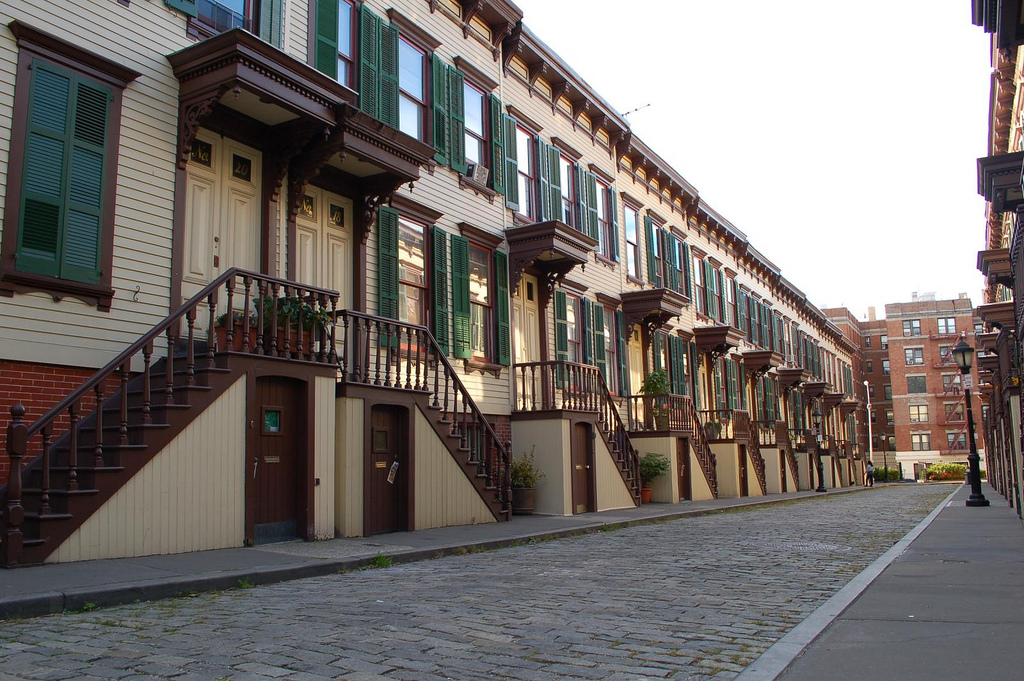
5. There are two ways to spend quality time in the historic district right now: One is considerably less expensive than the other.
Thometz and his wife operate The Jumel Terrace Bed and Breakfast in their home on West 160th Street. They rent a garden apartment—900 square feet with room for 4-6 people to sleep—for $375 per night during the week and $1,500 for a Friday, Saturday and Sunday stay.
And, for anyone who would like to spend a lot more time in the neighborhood, there’s a corner house on Sylvan Terrace available for sale right now.
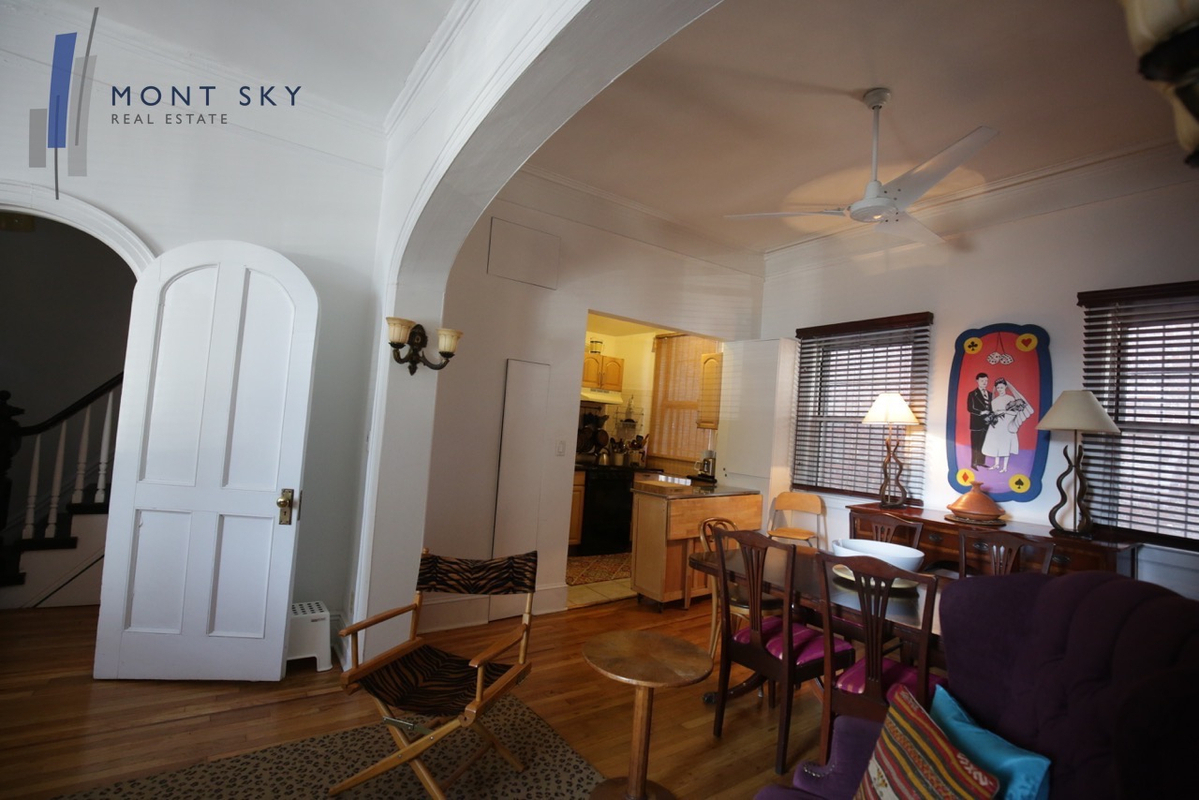
This home sits right across the road from the mansion, has three floors, plus a 500-square-foot, rental-ready studio apartment on the ground floor. There's a living room, dining area, kitchen with stainless steel appliances, and a half-bathroom on the first floor; and two bedrooms, a full bathroom and office on the second. The price tag: $1.697 million.
You Might Also Like



















